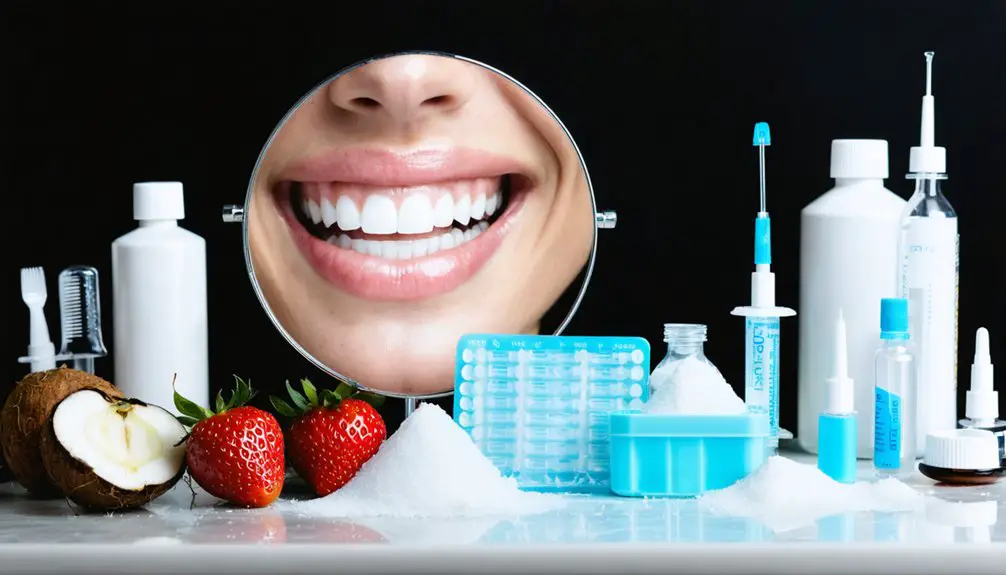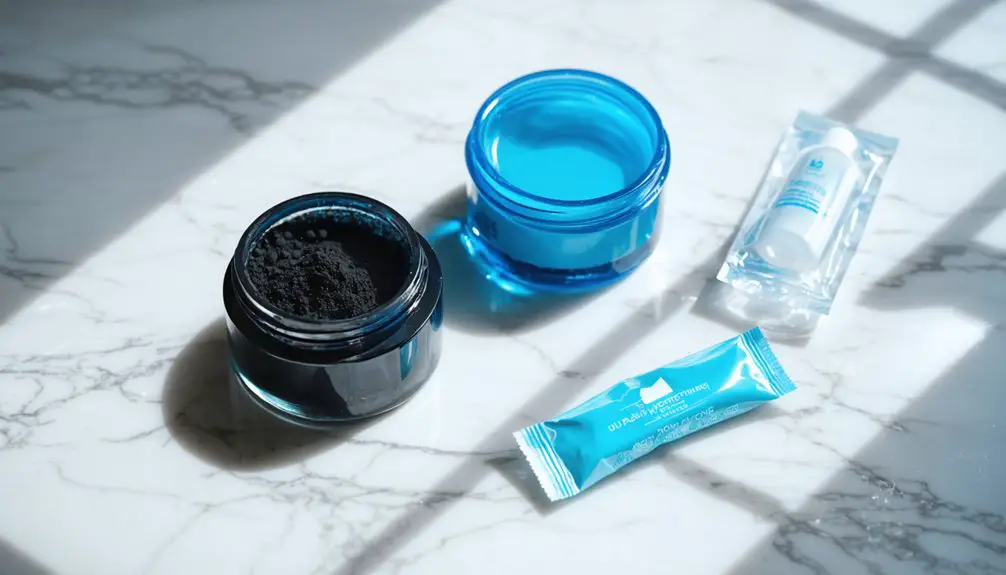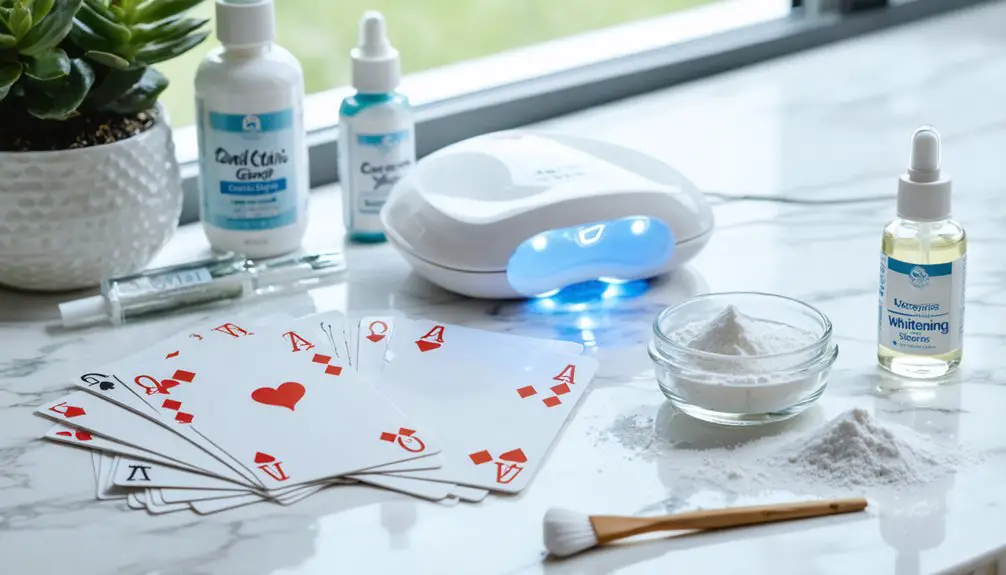You’ll achieve maximum cost-effectiveness by combining professional whitening treatments (25-40% peroxide) with at-home maintenance kits (3-10% peroxide). Custom-fit trays ($300-600) offer superior value through reusability and professional-grade gel compared to recurring OTC purchases. Schedule professional sessions every 6-12 months, using at-home touch-ups between visits. Implement preventive measures like proper oral hygiene and stain-avoiding habits. A strategic approach to timing and maintenance will optimize your whitening investment’s longevity.
Key Takeaways
- Combine professional treatments with at-home maintenance kits to reduce the frequency of expensive in-office sessions while maintaining results.
- Invest in custom-fit trays rather than disposable OTC products for better long-term value and reusability.
- Join dental membership programs offering 20-40% savings on whitening packages and include regular cleanings for comprehensive care.
- Schedule professional treatments every 6-18 months instead of frequent OTC touch-ups for better cost efficiency.
- Use preventive measures like straws for dark beverages and immediate rinsing to extend treatment longevity.
Combining Professional and At-Home Treatments for Maximum Value
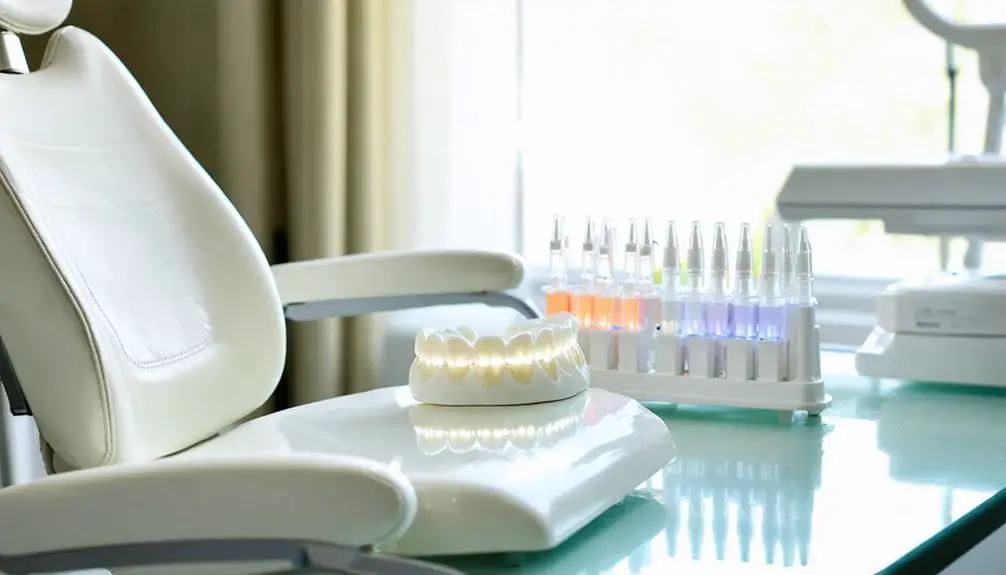
When considering long-term teeth whitening strategies, combining professional and at-home treatments offers the most cost-effective approach to achieving and maintaining a brighter smile.
Professional treatments with 25-40% peroxide concentration deliver dramatic results of up to 8 shades whiter in a single session, establishing a prime baseline for your smile. Regular consumption of coffee and wine can quickly reverse whitening results if not properly managed.
Professional teeth whitening treatments pack powerful peroxide concentrations that can transform your smile up to 8 shades brighter in one visit.
You’ll then maintain these results using milder at-home products containing 3-10% peroxide, which serve as cost-effective touch-ups between professional sessions. Proper oral hygiene practices and avoiding staining foods are essential for preserving whitening results.
This dual approach maximizes your investment by reducing the frequency of $300+ professional treatments while leveraging affordable $50 at-home kits for ongoing whitening maintenance.
You’ll benefit from your dentist’s supervision during professional sessions while enjoying the convenience and flexibility of at-home care to extend your results.
Strategic Timing of Whitening Sessions to Extend Results
Proper timing of teeth whitening sessions plays a key role in maximizing both the longevity of results and protecting your dental health.
For professional treatments, you’ll need to maintain timing intervals of 6-12 months to allow sufficient enamel recovery between sessions. If you’re using at-home kits, space treatments 3-6 months apart to prevent enamel erosion. Using professional-grade ingredients under dental supervision provides more reliable and longer-lasting whitening outcomes. Regular use of whitening toothpaste can help maintain brightness between major treatments.
To extend your results and protect enamel health, wait until any sensitivity subsides before pursuing additional treatments.
You can optimize your whitening investment by avoiding staining substances and maintaining excellent oral hygiene.
Consider combining occasional professional treatments with carefully timed at-home maintenance sessions.
Remember to consult your dentist to create a personalized timing strategy based on your specific enamel response and cosmetic objectives.
Preventive Measures to Maintain Whitening Investment
Maintaining your teeth whitening investment requires a thorough approach to preventive care and lifestyle modifications.
By implementing effective stain prevention strategies, you’ll protect your brightened smile and maximize the longevity of your treatment results.
Key preventive habits to safeguard your whitening investment include:
- Adopting strict oral hygiene routines with regular brushing, flossing, and professional cleanings
- Using a straw for dark beverages and rinsing immediately after consuming staining foods
- Quitting tobacco use and limiting exposure to highly pigmented foods and drinks
Focus on consistent dental care by replacing your toothbrush quarterly and using dentist-recommended whitening products.
Schedule regular check-ups to monitor your enamel health and receive professional guidance on maintaining your results.
Remember that the first 48 hours post-treatment are essential for establishing effective stain prevention practices.
Consider switching to an electric toothbrush for superior removal of surface stains and enhanced cleaning effectiveness.
Selecting clear alcoholic drinks like vodka or gin with light mixers can help prevent unwanted staining of your teeth.
Custom-Fit Trays vs. Multiple OTC Product Purchases
The decision between custom-fit whitening trays and over-the-counter products represents a significant investment choice in dental care.
Selecting between professional custom whitening trays and store-bought options can significantly impact both your smile and wallet.
While custom trays require $300-600 upfront, their cost analysis reveals superior long-term value through reusability and professional-grade gel efficiency.
SportingSmiles offers satisfaction guaranteed custom trays at a fraction of dental office costs.
Your investment in custom trays delivers enhanced product effectiveness through precise gel coverage and higher peroxide concentrations, achieving faster, more thorough whitening results.
Regular maintenance can be affected by lifestyle choices, such as coffee and wine consumption, requiring consistent touch-ups to maintain brightness.
You’ll benefit from minimized sensitivity risks due to better gum protection and professional supervision of your treatment plan.
Though OTC options offer lower initial costs under $100, you’ll face recurring expenses from frequent repurchases and potentially compromised results due to improper fit and lower concentrations.
Custom trays ultimately provide better value through durability, superior whitening outcomes, and reduced long-term maintenance costs.
Cost-Effective Maintenance Schedules for Different Treatment Types
You’ll achieve ideal cost savings by scheduling professional whitening maintenance every 6-18 months rather than frequent OTC touch-ups that require reapplication every 2-4 weeks.
At-home professional systems with custom trays offer a middle-ground solution, typically needing maintenance every 4-6 months while providing dental supervision for safety and efficacy. Professional in-office treatments deliver seven shades whiter results in a single session, making them highly efficient despite higher upfront costs. Over time, professional treatments prove to be more economical due to their lasting effects.
Your maintenance costs can be further reduced by adopting protective habits like using desensitizing products, maintaining excellent oral hygiene, and avoiding staining substances that accelerate discoloration.
Professional Treatment Maintenance Plans
Professional teeth whitening treatments require strategic maintenance schedules to maximize long-term value and sustain ideal results.
You’ll find significant long-term savings by selecting a maintenance plan that aligns with your chosen whitening method and lifestyle factors.
- In-office treatments ($300-$1,500) deliver immediate results with maintenance needed every 6-12 months, offering the longest-lasting effects.
- Take-home trays ($200-$600) require more frequent touch-ups but cost less per maintenance session.
- Membership programs bundle services, reducing costs by up to 30% while ensuring consistent maintenance frequency.
Consider combining an initial in-office treatment with take-home maintenance kits for peak cost-effectiveness.
This hybrid approach balances professional-grade results with economical upkeep, particularly when enrolled in a dental practice’s subscription plan that includes regular cleanings and whitening services.
At-Home Systems Schedule
Maintaining ideal whitening results requires a strategic at-home maintenance schedule tailored to your specific treatment type. For best whitening duration, begin with 10-14 consecutive days of initial treatment, wearing your trays daily as prescribed. You’ll notice changes after 3-4 applications.
To protect your enamel while maximizing results, schedule maintenance treatments every 3-6 months. If you experience sensitivity, reduce your at-home frequency to every other day or every third day. Always wait 24 hours between sessions and never exceed 14 consecutive days of treatment.
For sustained results, complement your whitening schedule with proper oral hygiene. Brush twice daily with whitening toothpaste, minimize staining beverages, and maintain regular dental cleanings.
Adjust your maintenance routine based on your sensitivity levels and lifestyle habits.
OTC Product Timing Guidelines
To maximize the cost-effectiveness of over-the-counter whitening products, it’s essential to follow specific timing guidelines based on your treatment type.
OTC product frequency depends on your chosen whitening method and lifestyle factors that contribute to staining. When incorporating whitening strip effectiveness into your maintenance routine, you’ll want to schedule treatments strategically.
- Apply whitening strips 1-2 times monthly between professional treatments, adhering to package instructions to prevent sensitivity.
- Use ADA-approved whitening toothpaste daily for surface stain removal, replacing your toothbrush every three months.
- Schedule at-home gel tray applications for 3-4 consecutive days when you notice color relapse, typically twice yearly.
Remember to monitor your teeth’s response and adjust frequency based on sensitivity while maintaining consistent oral hygiene practices.
Smart Product Selection Based on Long-Term Results
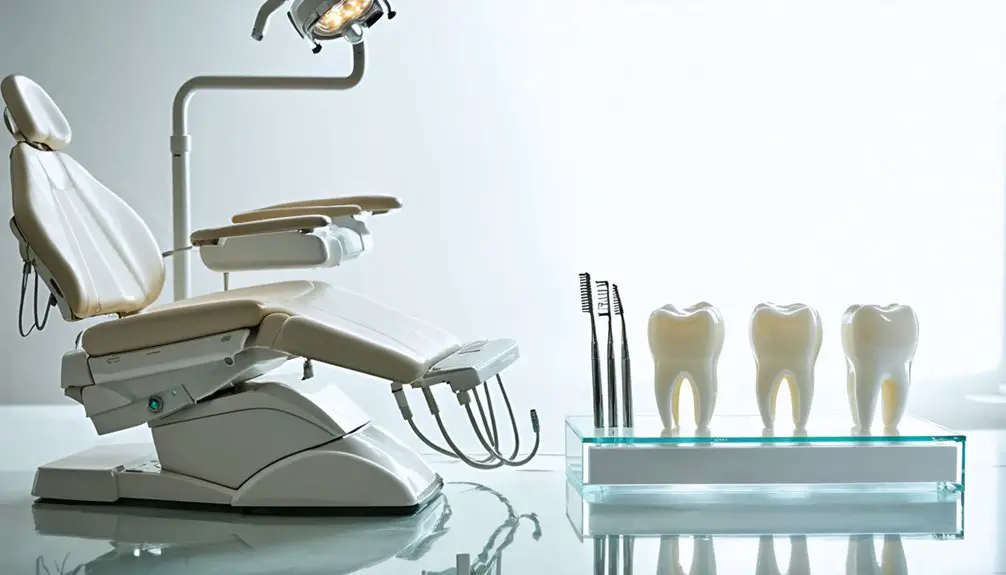
When selecting teeth whitening products for lasting results, understanding the effectiveness of active ingredients becomes essential for maximizing your investment.
While natural alternatives like baking soda offer gentle treatment, peroxide-based products consistently deliver superior results, especially for stubborn stains.
Choose professional-grade strips or custom-fitted trays with appropriate peroxide concentration for your needs. These options provide ideal contact time and uniform application, leading to better long-term color stability.
For deep stains, higher concentration products (25% carbamide peroxide) may be necessary, but require careful monitoring to prevent sensitivity.
To maintain results for up to a year, implement a strategic maintenance plan combining monthly touch-ups with professional cleanings.
This approach helps preserve your whitening investment while protecting enamel integrity through controlled, consistent applications.
Professional Treatment Package Deals and Financing Options
Professional treatment packages release substantial cost advantages while maintaining clinical-grade whitening results. Through package customization and strategic financing options, you’ll access premium whitening services at 20-40% below individual treatment costs.
Many practices offer CareCredit and flexible payment plans spanning 6-24 months, making advanced procedures like Zoom® whitening more attainable.
- Combine in-office treatments with take-home maintenance kits for prolonged efficacy
- Access interest-free financing periods through third-party providers
- Utilize seasonal promotions and referral discounts for additional savings
Your investment in professional whitening packages typically includes consultation, personalized treatment protocols, and follow-up care.
Professional whitening packages deliver comprehensive care through expert consultations, customized treatments, and dedicated follow-up support.
When evaluating options, consider package contents, financing terms, and maintenance provisions to optimize your long-term whitening success while maximizing cost efficiency.
Maximizing Insurance and Dental Plan Benefits
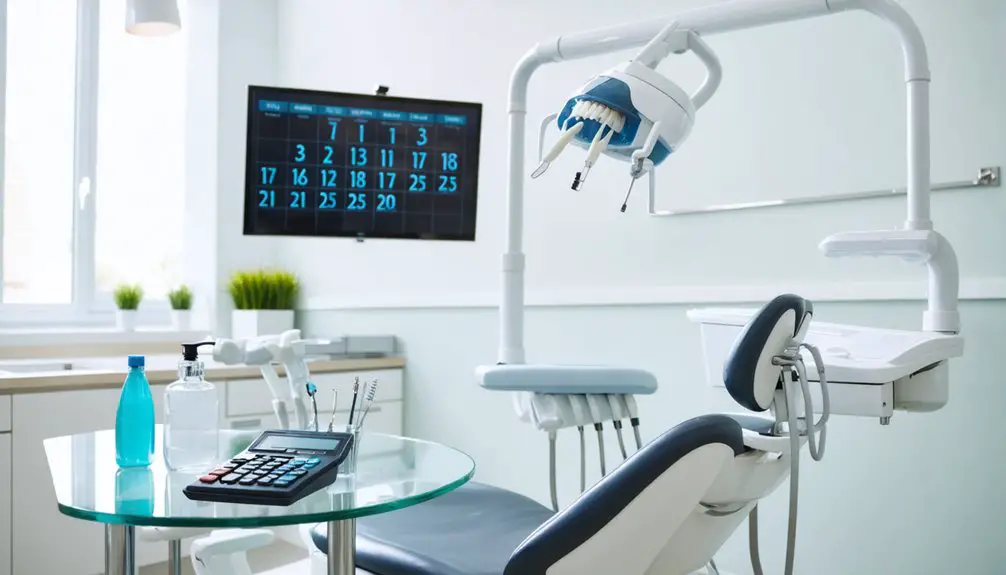
Although teeth whitening is typically classified as a cosmetic procedure, you’ll find strategic ways to leverage dental plans and insurance benefits for cost savings.
Start by exploring insurance loopholes through dental savings plans, which offer 15-50% discounts on whitening treatments without waiting periods or deductibles.
Consider plan comparisons between traditional insurance and specialized programs like Humana Bright Plus, which provides a $100 annual whitening allowance.
Some policies, such as Guardian Direct Diamond, cover 50% of costs after meeting deductibles.
To maximize your benefits, verify network providers and combine routine preventive care with dental savings memberships.
Review your plan benefits annually, as coverage options may change, and consult with plan administrators to understand specific restrictions and eligibility requirements for whitening treatments.
DIY Support Methods to Prolong Whitening Effects
Maintaining professional whitening results requires strategic at-home care and lifestyle modifications.
You’ll maximize your whitening investment through proven DIY whitening tips and natural stain removers that protect your enamel while preserving brightness.
- Create a gentle whitening paste by mixing baking soda with hydrogen peroxide, applying once weekly to polish surface stains without damaging enamel.
- Practice oil pulling with coconut oil daily to reduce plaque accumulation and maintain oral hygiene.
- Stimulate saliva production by chewing sugar-free gum, which naturally neutralizes acids and helps remove stains.
When implementing these methods, maintain consistent oral hygiene practices and avoid direct application of acidic substances to your teeth.
Remember to brush with soft bristles, rinse thoroughly after consuming staining beverages, and use a straw when drinking dark-colored liquids to minimize contact with tooth surfaces.
Annual Cost Comparison of Different Whitening Methods
When evaluating teeth whitening options, you’ll find significant cost variations across different treatment methods, ranging from basic over-the-counter products to advanced laser procedures.
The cost disparities directly correlate with product effectiveness: while OTC products cost $5-$400 annually with short-term results, professional in-office treatments range from $300-$1,000 with effects lasting up to three years.
Professional teeth whitening may cost more upfront, but its longer-lasting results make it more cost-effective than repeated over-the-counter treatments.
Dentist-prescribed at-home kits fall in the middle at $100-$600 per cycle.
Advanced laser whitening, though initially more expensive at $611-$1,368, often requires fewer repeat sessions.
When calculating annual maintenance costs, consider that OTC products may require multiple purchases throughout the year, potentially exceeding $400, while professional treatments might need only one annual touch-up session for sustained results.
Frequently Asked Questions
Does Dental Bonding or Veneers Affect the Success of Whitening Treatments?
Yes, both affect whitening success considerably. Your bonding durability won’t respond to whitening agents, while veneer compatibility is non-existent since porcelain can’t be whitened through traditional bleaching methods.
Can Teeth Become Resistant to Whitening Products Over Time?
Like a shield worn thin, your teeth don’t become resistant to whitening products, but repeated treatments can damage enamel, increasing sensitivity and reducing whitening effectiveness due to structural changes.
How Do Medications Impact the Effectiveness and Longevity of Teeth Whitening?
Your medication types can considerably reduce whitening duration, as antibiotics, antidepressants, and antihistamines cause both internal and external staining, while dry-mouth side effects accelerate new discoloration after treatment.
Are Natural Whitening Alternatives More Cost-Effective Than Commercial Products Long-Term?
While natural methods have lower initial costs, they’re less predictable and may require more frequent application. Commercial treatments offer better validated results and safety profiles, making them more cost-effective over time.
Which Underlying Dental Conditions Could Make Whitening Treatments Ineffective or Wasteful?
Your teeth won’t whiten effectively if you’ve got cavities, exposed dentin, gum disease, or internal staining. These underlying issues need treatment first – don’t waste money on whitening until your dental health’s stable.
References
- https://blyssdental.com/how-long-does-teeth-whitening-last/
- https://lanedds.com/?p=26079
- https://gorgeoussmilesdental.com/blog/best-teeth-whitening-treatments-recommended-by-dentists/
- https://pmc.ncbi.nlm.nih.gov/articles/PMC4058574/
- https://nhdentistrybeverlyhills.com/press/6-of-the-best-teeth-whitening-kits-in-the-drugstore/
- https://www.veenstradental.com/blog/at-home-vs-professional-teeth-whiteningwhats-the-difference-
- https://www.dentalassociates.com/blog/professional-teeth-whitening-vs-at-home-teeth-whitening
- https://www.smileslosgatos.com/articles/professional-teeth-whitening-vs-at-home-kits
- https://orcharddentist.com/the-benefits-of-professional-teeth-whitening-vs-at-home-kits/
- https://www.loveyoursmile.dentist/blog/professional-teeth-whitening-vs-whitening-trays/

